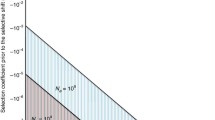Abstract
A common outcome of disruptive selection experiments between two differentiated populations which produce disadvantageous hybrids is an increase in homogamy. Experiments reported here result in another outcome when ‘classical’ selection experiments are redesigned. In these modified experiments, frequencies of genotypes in the mating population were not artificially maintained at parity but were instead determined from progeny proportions in the previous generation. In these selection lines another outcome, apart from an increase in homogamy, was demonstrated. Under a high selection coefficient against heterozygotes, elimination of a homozygote and the corresponding fixation of the other was observed. No selection line demonstrated the maintenance of two differentiated populations concurrently with the selection process of heterozygote disadvantage. A high number of generations of selection under this population genetical process is necessary to increase differences between two populations. However, the instability of gene frequencies which results in fixation or elimination of a homozygote is shown to be extremely rapid by comparison. Classical experiments were repeated and after 21 generations of selection there was no increase in divergence. For lower selection coefficients, high levels of introgression are apparent, and hence the genetical distinctness of the two populations decreases over time. This is in addition to the problem of an unstable equilibrium under selection against heterozygotes. Both aspects are important but not previously considered in experimental evidence for speciation models for which their implications are discussed.
Similar content being viewed by others
References
Ayala, F. J., 1975. Genetic differentiation during the speciation process. Evol. Biol. 8: 1–75.
Crossley, S. A., 1974. Changes in mating behaviour produced by selection for ethological isolation between ebony and vestigial mutants of Drosophila melanogaster. Evolution 28: 631–647.
Crow, J. F. & Kimura, M., 1970. An introduction to population genetics theory. Harper & Row, London.
Dobzhansky, Th., Ayala, F. J., Stebbins, G. L. & Valentine, J. W., 1977. Evolution, W. H. Freeman, San Francisco.
Foster, G. G., Whitten, M. J., Prout, T. & Gill, R., 1972. Chromosome rearrangements for the control of insect pests. Science 176: 875–880.
Futuyama, D. J., 1979. Evolutionary biology. Sinauer Sunderland, Massachusetts.
Harper, A. A. & Lambert, D. M., 1983. Disruptive selection for homogamy in mutant strains of Drosophila melanogaster. Dros. Inf. Serv. (in press).
Hoenigsberg, H. F., 1964. Selection for sexual isolation in Drosophila. Dros. Inf. Serv. 39: 128–129.
Kessler, S., 1966. Selection for and against ethological isolation between Drosophila pseudoobscura and Drosophila persimilis. Evolution 20: 634–645.
Koopman, K., 1950. Natural selection for reproductive isolation between Drosophila pseudoobscura and Drosophila persimilis. Evolution 4: 135–148.
Levene, H., 1953. Genetic equilibrium when more than one ecological niche is available. Am. Nat. 87: 331–333.
Lewontin, R. C., 1974. The genetic basis of evolutionary change. Columbia Univ. Press, New York.
Li, C. C., 1955. The stability of an equilibrium and the average fitness of a population. Am. Nat. 89: 281–295.
Littlejohn, M. J., 1981. Reproductive isolation ‘a critical review’. In: Evolution and Speciation. Essays in honor of M. J. D. White., eds W. R. Atchley & D. S. Woodruff: 298–334.
Mather, K. E., 1973. Genetical structure of populations. Chapman & Hall, London.
Muller, H. J., 1942. Isolating mechanisms, evolution and temperature. Biological Symposia 6: 71–125.
Paterson, H. E. H., 1978. More evidence against speciation by reinforcement. S. Afr. J. Sci. 74: 369–371.
Pearce, S., 1960. An experimental study of sexual isolation with the species Drosophila melanogaster. Anim. Behav. 8: 232–233.
Petit, C., 1980. ‘How many genes are involved in sexual isolation?’ Genetika 12: 133–145.
Petit, C., Kitagawa, O., Takanashi, E. & Nouaud, D., 1980. The failure to obtain sexual isolation by artificial selection. Genetica 54: 213–219.
Spiess, E. B., 1977. Genes in population. John Wiley, London.
Wallace, B., 1954. Genetic divergence of isolated populations of Drosophila melanogaster. Caryologia, 6. suppl.: 761–764.
Wallace, B., 1968. Topics in population genetics. Norton, London.
Whitten, M. J., 1971. Insect control by genetic manipulation of natural populations. Science 171: 682–684.
Wilson, D. S. & Hedrick, A., 1982. Speciation and the economics of mate choice. Evol. Theory 6: 15–24.
Author information
Authors and Affiliations
Additional information
Publication No. 2, Evolutionary Genetics Laboratory, University of Auckland.
Rights and permissions
About this article
Cite this article
Harper, A.A., Lambert, D.M. The population genetics of reinforcing selection. Genetica 62, 15–23 (1983). https://doi.org/10.1007/BF00123305
Received:
Accepted:
Issue Date:
DOI: https://doi.org/10.1007/BF00123305




